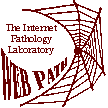- What type of white blood cells are present?
The white blood cell count is moderately elevated, with a wide spectrum of granulocytes at various stages of maturation (rare blasts and promyelocytes, myelocytes, metamyelocytes, bands, and PMN's). In addition, there is an increase in eosinophils and basophils (which would help to rule out a leukemoid reaction as a cause for the WBC elevation). Platelets are moderately increased in number and some large forms are seen.
- What is the differential diagnosis and how would you resolve it?
The differential diagnosis is leukemoid reaction versus chronic granulocytic leukemia. The increase in eosinophils and basophils suggests leukemia. A leukocyte alkaline phosphatase (LAP) score would also help (high with leukemoid reaction, low with myelogenous leukemia).
- What is a cytogenetic analysis of the bone marrow likely to show?
The karyotype in CML typically reveals a "Philadelphia chromosome" which is a t(9;22) that yields fusion of bcr-abl, and the fusion gene product is a tyrosine kinase that drives cellular proliferation. This mutation occurs early in differentiation so that any or all 3 major cell lines can be affected.
- What is the diagnosis in this case?
The diagnosis is chronic granulocytic (myelogenous) leukemia (CML).



